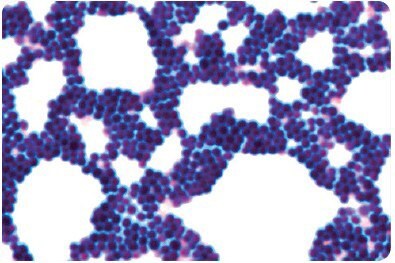Bacteriology

The discipline of bacteriology is concerned with all aspects of genetics, structure, physiology, behavior, pathogenicity, ecology, and evolution of bacterial species. Bacteriological investigations are essential in clinical diagnostics and industrial quality control. Application of microscopy in bacteriology involves the staining of microorganisms with suitable methods (e.g. Gram stain) to determine the Bacteria classification or to detect mycobacteria.
Common diagnostic bacteriology stains and their uses
Gram Staining
Gram staining is an essential staining technique in bacteriology used to differentiate Gram-positive and Gram-negative bacteria. In this method, differentiation is achieved as Gram-positive bacteria retain a crystal violet stain due to the presence of a thick layer of peptidoglycan in their cell walls.
Alternatively, Gram-negative bacteria are decolorized by organic solvent and turn orange-pink when counterstained, which is attributed to a thinner peptidoglycan wall. Reagents required for this multi-step staining process include crystal violet (primary stain), aniline dye, iodine solution (mordant), and safranin orange (secondary stain), or carbol fuchsin counterstains.
Mycobacteria Staining
Early diagnosis of mycobacterial infection is critical, as the acid-fast bacteria are highly pathogenic and responsible for serious diseases, like tuberculosis. Diverse staining solutions are available for the detection of these pathogenic bacteria in histological tissue cultures and bacteriological smears. Fluorescence detection methods are utilized with the Ziehl-Neelsen staining technique, via either heat-treated slides (hot staining) or non-heated treatment (cold staining). This differential staining technique uses the lipid-soluble phenolic compound carbol fuchsin as the primary stain, and the counterstain, malachite green.
Trichomonad Staining
Trichomonas vaginalis parasites are especially common in gynaecological material, such as vaginal smears and urine sediment, and cause the most common non-viral sexually transmitted disease, trichomoniasis. Various stains like Giemsa and Acridine Orange, are used along with wet mount examination for the microscopic diagnosis of Trichomonas vaginalis.
Bacteriology applications in other industries
In the food and beverage industry, lactic acid bacteria such as Lactobacillus, Lactococcus, and Streptococcus are used in the manufacture of dairy products, such as cheese, buttermilk, and yogurt. Bacterial fermentations are used in the processing of beverages, such as tea and coffee. In the growing field of gut microbiome health, several bacterial species are used in probiotic supplements to reduce inflammation and improve bowel function. Bacteria are also used in the pharmaceutical industry in vaccine research and production, including tetracyclines, erythromycin by Streptomyces and bacitracin by Bacillus.
Related Technical Articles
- Information about lactobacilli, rod-shaped, Gram-positive, fermentative, facultative anaerobic or microaerophilic organotrophs. The lactobacillus organtroph belongs to the lactic acid bacteria group.
- Chromogenic media enable the selective detection of S. aureus, which produce bluish-green colonies that are clearly differentiated from other species.
- Selective media enable faster results and visual confirmation for the detection, identification, and enumeration of microorganisms
- With bacterial resistance and emerging infectious diseases becoming potential threats to humans, ribosomally synthesized antimicrobial peptides have become a promising focus area in antibiotic research.
- Explore our staining kits and solutions for bacteriological differentiation and diagnostics. Our bacteriology products are all IVDs, CE certified and ready to use.
- See All (24)
Related Protocols
- Cell culture protocol for testing cell lines for bacterial and fungal contamination. Free ECACC handbook download.
- Initiating a Starter Culture
- General protocols for growth of competent cells in microbial medium.
- Learn how to properly clean your laboratory glassware to improve your lab technique and insure high quality results. The most carefully executed piece of work may give an erroneous result if dirty glassware is used.
- Lipopolysaccharides (LPS) are characteristic components of the cell wall of Gram negative bacteria; they are not found in Gram positive bacteria. They are localized in the outer layer of the membrane and are, in noncapsulated strains, exposed on the cell surface. They contribute to the integrity of the outer membrane, and protect the cell against the action of bile salts and lipophilic antibiotics.
- See All (9)
Common diagnostic bacteriology stains and their uses |
|---|
To continue reading please sign in or create an account.
Don't Have An Account?